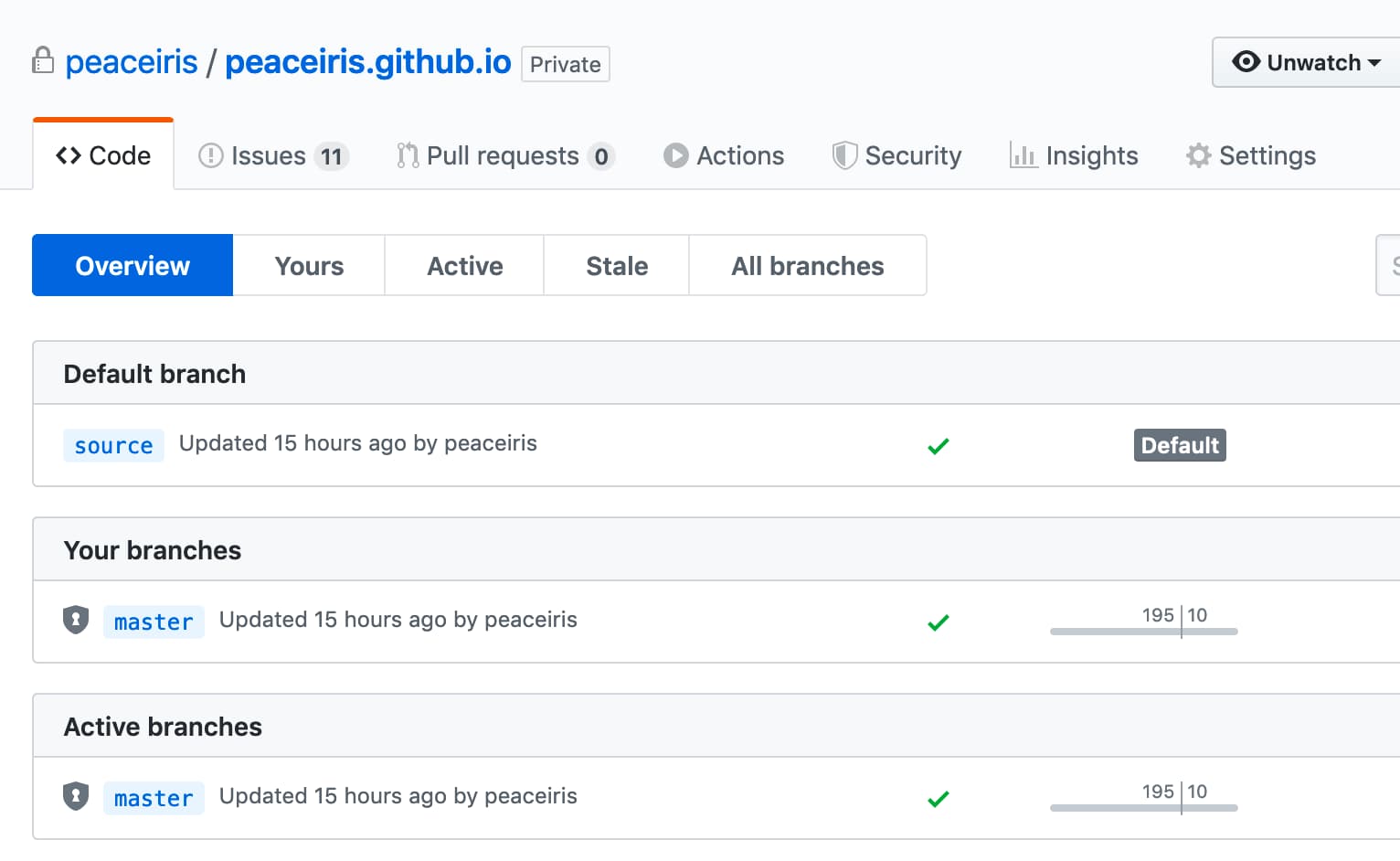
This Action has been migrated to a TypeScript Action (version 3). The old Docker Action is peaceiris/actions-gh-pages@v2
GitHub Actions for GitHub Pages
This is a GitHub Action to deploy your static files to GitHub Pages. This deploy action can be combined simply and freely with Static Site Generators. (Hugo, MkDocs, Gatsby, GitBook, mdBook, and so on.)
The next example step will deploy ./public directory to the remote gh-pages branch.
- name: Deploy
uses: peaceiris/actions-gh-pages@v3
with:
github_token: ${{ secrets.GITHUB_TOKEN }}
publish_dir: ./public
Supported Tokens
Three tokens are supported.
| Token | Private repo | Public repo | Protocol | Setup |
|---|---|---|---|---|
github_token |
✅️ | ✅️ | HTTPS | Unnecessary |
deploy_key |
✅️ | ✅️ | SSH | Necessary |
personal_token |
✅️ | ✅️ | HTTPS | Necessary |
Notes: Actually, the GITHUB_TOKEN works for deploying to GitHub Pages but it has still some limitations. For the first deployment, we need to select the gh-pages branch or master branch on the repository settings tab. See First Deployment with GITHUB_TOKEN
Supported Platforms
All Actions runners: Linux (Ubuntu), macOS, and Windows are supported.
| runs-on | github_token |
deploy_key |
personal_token |
|---|---|---|---|
| ubuntu-18.04 | ✅️ | ✅️ | ✅️ |
| ubuntu-16.04 | ✅️ | ✅️ | ✅️ |
| macos-latest | ✅️ | ✅️ | ✅️ |
| windows-latest | ✅️ | (2) | ✅️ |
- WIP, See Issue #87
Table of Contents
Getting started
⭐️ Repository type - Project
Add your workflow file .github/workflows/gh-pages.yml and push to the remote master branch.
An example workflow for Hugo.
name: github pages
on:
push:
branches:
- master
jobs:
deploy:
runs-on: ubuntu-18.04
steps:
- uses: actions/checkout@v2
with:
submodules: true # Fetch Hugo themes
fetch-depth: 0 # Fetch all history for .GitInfo and .Lastmod
- name: Setup Hugo
uses: peaceiris/actions-hugo@v2
with:
hugo-version: '0.68.3'
- name: Build
run: hugo --minify
- name: Deploy
uses: peaceiris/actions-gh-pages@v3
with:
github_token: ${{ secrets.GITHUB_TOKEN }}
publish_dir: ./public
The above example is for Project Pages sites. (<username>/<project_name> repository)
| Actions log overview | GitHub Pages log |
|---|---|
 |
 |
⭐️ Repository type - User and Organization
For User and Organization Pages sites (<username>/<username>.github.io repository),
we have to set master branch to publish_branch.
A default value of publish_branch is gh-pages.
on:
push:
branches:
- source # default branch
jobs:
deploy:
runs-on: ubuntu-18.04
steps:
- uses: actions/checkout@v2
- run: somebuild
- name: Deploy
uses: peaceiris/actions-gh-pages@v3
with:
github_token: ${{ secrets.GITHUB_TOKEN }}
publish_dir: ./public
publish_branch: master # deploying branch
Options
⭐️ github_token
This option is for GITHUB_TOKEN, not a personal access token.
GitHub Actions runner automatically creates a GITHUB_TOKEN secret to use in your workflow. You can use the GITHUB_TOKEN to authenticate in a workflow run.
- name: Deploy
uses: peaceiris/actions-gh-pages@v3
with:
github_token: ${{ secrets.GITHUB_TOKEN }}
publish_dir: ./public
For more details about GITHUB_TOKEN: Authenticating with the GITHUB_TOKEN - GitHub Help
⭐️ deploy_key
Read Create SSH Deploy Key, create your SSH deploy key, and set the deploy_key option like the following.
- name: Deploy
uses: peaceiris/actions-gh-pages@v3
with:
deploy_key: ${{ secrets.ACTIONS_DEPLOY_KEY }}
publish_dir: ./public
⭐️ personal_token
Generate a personal access token (repo) and add it to Secrets as PERSONAL_TOKEN, it works as well as ACTIONS_DEPLOY_KEY.
- name: Deploy
uses: peaceiris/actions-gh-pages@v3
with:
personal_token: ${{ secrets.PERSONAL_TOKEN }}
publish_dir: ./public
⭐️ publish_branch
A target branch to deploy to GitHub Pages. The default is gh-pages.
- name: Deploy
uses: peaceiris/actions-gh-pages@v3
with:
github_token: ${{ secrets.GITHUB_TOKEN }}
publish_branch: master # default: gh-pages
⭐️ publish_dir
A target directory to deploy to GitHub Pages. The default is public.
- name: Deploy
uses: peaceiris/actions-gh-pages@v3
with:
github_token: ${{ secrets.GITHUB_TOKEN }}
publish_dir: ./out # default: public
⭐️ CNAME
To add CNAME file, we can set the cname option.
For more details about CNAME, read the official documentation: Managing a custom domain for your GitHub Pages site - GitHub Help
- name: Deploy
uses: peaceiris/actions-gh-pages@v3
with:
github_token: ${{ secrets.GITHUB_TOKEN }}
publish_dir: ./public
cname: github.com
⭐️ Enable Built-in Jekyll
If you want GitHub Pages to process your site with the static site generator Jekyll, set enable_jekyll to true.
github/personal-website is one of the examples using GitHub Pages built-in Jekyll.
By default, this action signals to GitHub Pages that the site shall not be processed with Jekyll. This is done by adding an empty .nojekyll file when publishing to the master or gh-pages branch. When a .nojekyll file already exists, this action does nothing.
Bypassing Jekyll makes the deployment faster and is necessary if you are deploying files or directories that start with underscores, since Jekyll considers these to be special resources and does not copy them to the final site. You only need to set enable_jekyll to true when you want to deploy a Jekyll-powered website and let GitHub Pages do the Jekyll processing.
- name: Deploy
uses: peaceiris/actions-gh-pages@v3
with:
github_token: ${{ secrets.GITHUB_TOKEN }}
publish_dir: ./public
enable_jekyll: true
For more details about .nojekyll: Bypassing Jekyll on GitHub Pages - The GitHub Blog
⭐️ Allow empty commits
By default, a commit will not be generated when no file changes. If you want to allow an empty commit, set the optional parameter allow_empty_commit to true.
For example:
- name: Deploy
uses: peaceiris/actions-gh-pages@v3
with:
github_token: ${{ secrets.GITHUB_TOKEN }}
publish_dir: ./public
allow_empty_commit: true
⭐️ Keeping existing files
By default, existing files in the publish branch are removed before adding the ones from publish dir. If you want the action to add new files but leave existing ones untouched, set the optional parameter keep_files to true.
For example:
- name: Deploy
uses: peaceiris/actions-gh-pages@v3
with:
github_token: ${{ secrets.GITHUB_TOKEN }}
publish_dir: ./public
keep_files: true
⭐️ Deploy to external repository
By default, your files are published to the repository which is running this action.
If you want to publish to another repository on GitHub, set the environment variable external_repository to <username>/<external-repository>.
For example:
- name: Deploy
uses: peaceiris/actions-gh-pages@v3
with:
deploy_key: ${{ secrets.ACTIONS_DEPLOY_KEY }}
external_repository: username/external-repository
publish_branch: master
publish_dir: ./public
You can use deploy_key or personal_token.
When you use deploy_key, set your private key to the repository which includes this action and set your public key to your external repository.
Be careful, GITHUB_TOKEN has no permission to access to external repositories.
⭐️ Force orphan
We can set the force_orphan: true option.
This allows you to make your publish branch with only the latest commit.
- name: Deploy
uses: peaceiris/actions-gh-pages@v3
with:
github_token: ${{ secrets.GITHUB_TOKEN }}
publish_dir: ./public
force_orphan: true
⭐️ Set Git username and email
Set custom git config user.name and git config user.email.
A commit is always created with the same user.
- name: Deploy
uses: peaceiris/actions-gh-pages@v3
with:
github_token: ${{ secrets.GITHUB_TOKEN }}
publish_dir: ./public
user_name: 'github-actions[bot]'
user_email: 'github-actions[bot]@users.noreply.github.com'
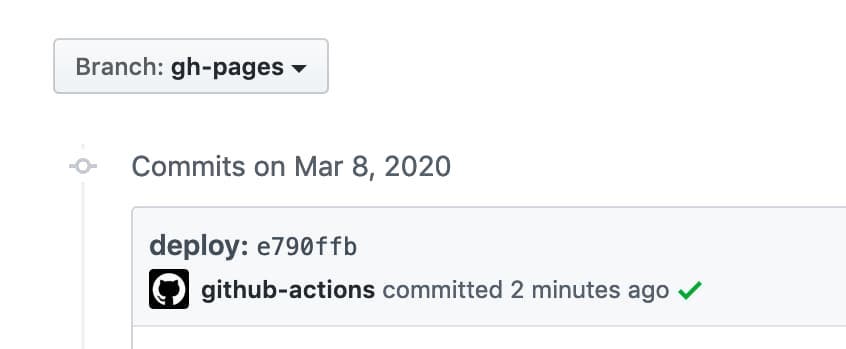
⭐️ Set custom commit message
Set custom commit message.
When we create a commit with a message docs: Update some post, a deployment commit will be generated with a message docs: Update some post ${GITHUB_SHA}.
- name: Deploy
uses: peaceiris/actions-gh-pages@v3
with:
github_token: ${{ secrets.GITHUB_TOKEN }}
publish_dir: ./public
commit_message: ${{ github.event.head_commit.message }}
To set a full custom commit message without a triggered commit hash,
use the full_commit_message option instead of the commit_message option.
- name: Deploy
uses: peaceiris/actions-gh-pages@v3
with:
github_token: ${{ secrets.GITHUB_TOKEN }}
publish_dir: ./public
full_commit_message: ${{ github.event.head_commit.message }}
⭐️ Create Git tag
Here is an example workflow.
name: github pages
on:
push:
branches:
- master
tags:
- 'v*.*.*'
jobs:
deploy:
runs-on: ubuntu-18.04
steps:
- uses: actions/checkout@v2
- name: Some build
- name: Prepare tag
id: prepare_tag
if: startsWith(github.ref, 'refs/tags/')
run: |
TAG_NAME="${GITHUB_REF##refs/tags/}"
echo "::set-output name=tag_name::${TAG_NAME}"
echo "::set-output name=deploy_tag_name::deploy-${TAG_NAME}"
- name: Deploy
uses: peaceiris/actions-gh-pages@v3
with:
github_token: ${{ secrets.GITHUB_TOKEN }}
publish_dir: ./public
tag_name: ${{ steps.prepare_tag.outputs.deploy_tag_name }}
tag_message: 'Deployment ${{ steps.prepare_tag.outputs.tag_name }}'
Commands on a local machine.
$ # On the master branch
$ git tag -a "v1.2.3" -m "Release v1.2.3"
$ git push origin "v1.2.3"
$ # After deployment
$ git fetch origin
$ git tag
deploy-v1.2.3 # Tag on the gh-pages branch
v1.2.3 # Tag on the master branch
Tips and FAQ
⭐️ Create SSH Deploy Key
Generate your deploy key with the following command.
ssh-keygen -t rsa -b 4096 -C "$(git config user.email)" -f gh-pages -N ""
# You will get 2 files:
# gh-pages.pub (public key)
# gh-pages (private key)
Next, Go to Repository Settings
- Go to Deploy Keys and add your public key with the Allow write access
- Go to Secrets and add your private key as
ACTIONS_DEPLOY_KEY
| Add your public key | Success |
|---|---|
 |
 |
| Add your private key | Success |
|---|---|
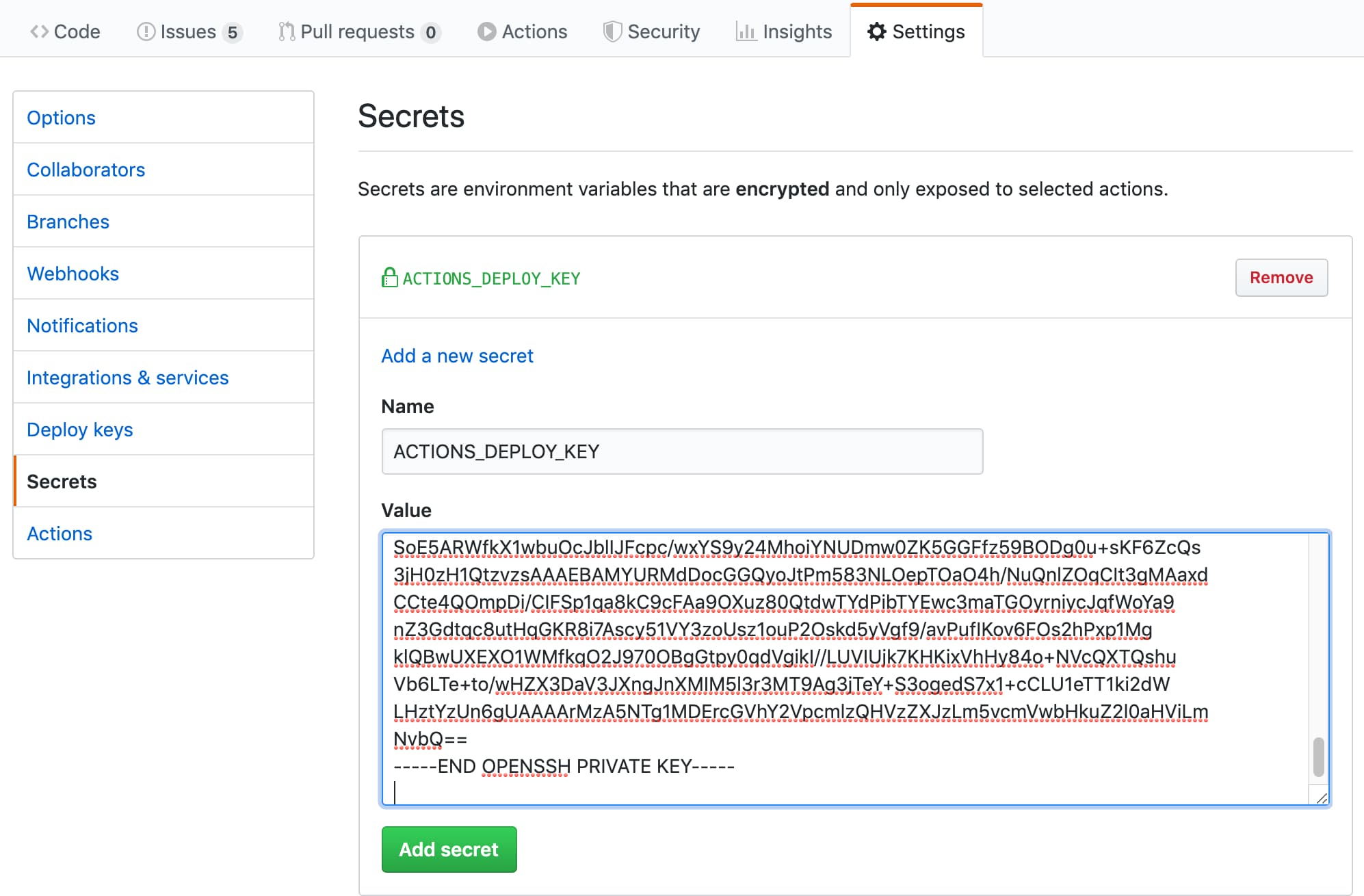 |
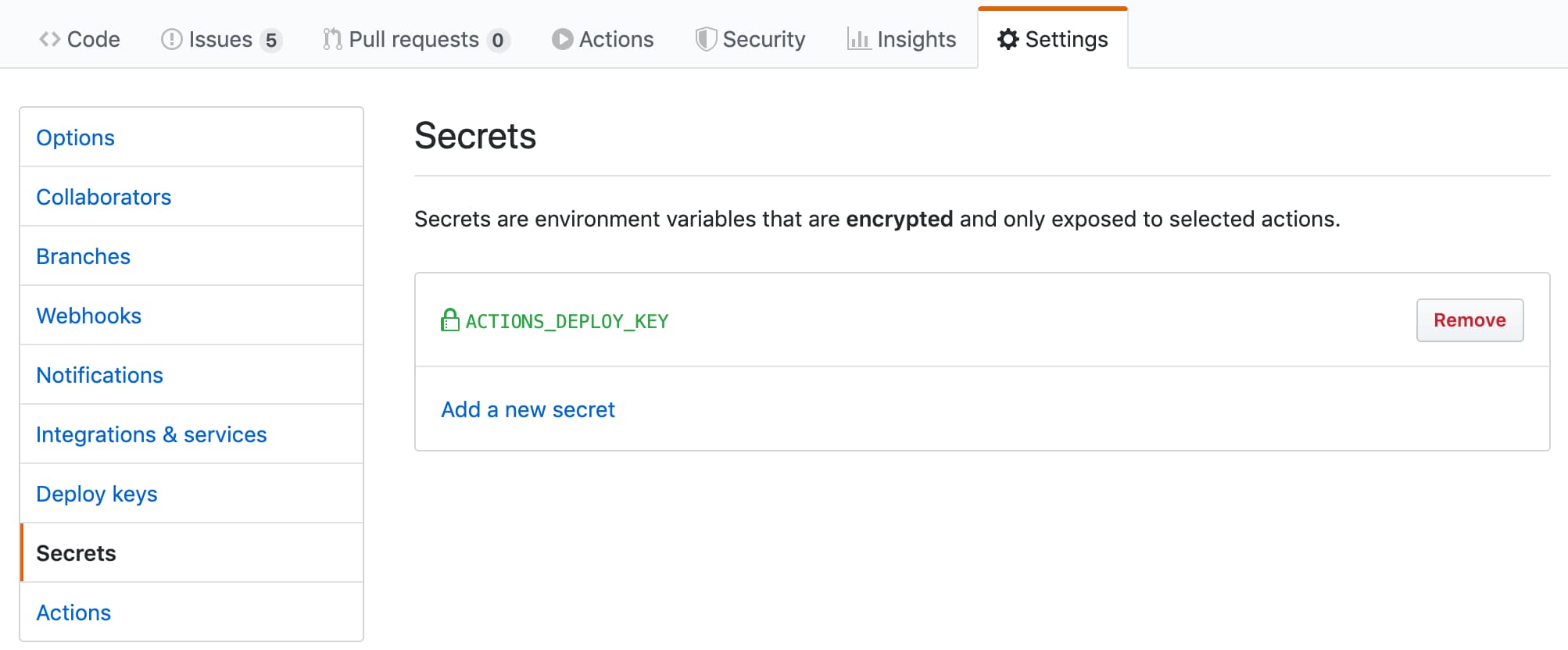 |
⭐️ First Deployment with GITHUB_TOKEN
The GITHUB_TOKEN has limitations for the first deployment so we have to select the GitHub Pages branch on the repository settings tab. After that, do the second deployment like the following pictures.
| First deployment failed | Go to the settings tab |
|---|---|
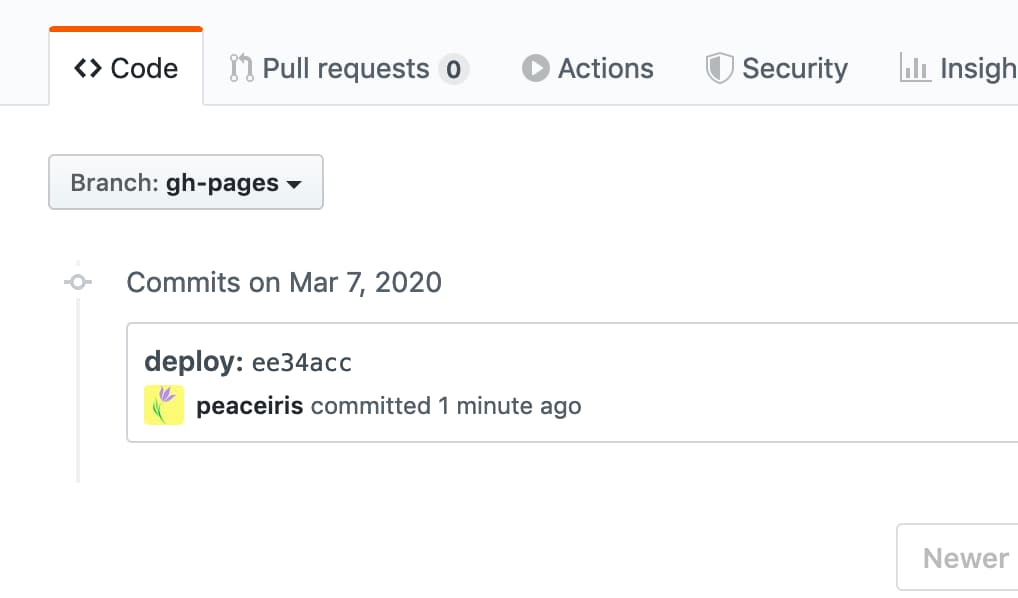 |
 |
| Select branch | Deploying again and succeed |
|---|---|
 |
 |
⭐️ Use the latest and specific release
We recommend you to use the latest and specific release of this action for stable CI/CD. It is useful to watch this repository (release only) to check the latest release of this action.
Examples
⭐️ Static Site Generators with Node.js
hexo, gitbook, vuepress, react-static, gridsome, and so on.
Premise: Dependencies are managed by package.json and package-lock.json
name: github pages
on:
push:
branches:
- master
jobs:
deploy:
runs-on: ubuntu-18.04
steps:
- uses: actions/checkout@v2
- name: Setup Node
uses: actions/setup-node@v1
with:
node-version: '12.x'
- name: Cache dependencies
uses: actions/cache@v1
with:
path: ~/.npm
key: ${{ runner.os }}-node-${{ hashFiles('**/package-lock.json') }}
restore-keys: |
${{ runner.os }}-node-
- run: npm ci
- run: npm run build
- name: Deploy
uses: peaceiris/actions-gh-pages@v3
with:
github_token: ${{ secrets.GITHUB_TOKEN }}
publish_dir: ./public
⭐️ Gatsby
An example for Gatsby (Gatsby.js) project with gatsby-starter-blog
name: github pages
on:
push:
branches:
- master
jobs:
deploy:
runs-on: ubuntu-18.04
steps:
- uses: actions/checkout@v2
- name: Setup Node
uses: actions/setup-node@v1
with:
node-version: '12.x'
- name: Cache dependencies
uses: actions/cache@v1
with:
path: ~/.npm
key: ${{ runner.os }}-node-${{ hashFiles('**/package-lock.json') }}
restore-keys: |
${{ runner.os }}-node-
- run: npm ci
- run: npm run format
- run: npm run test
- run: npm run build
- name: Deploy
uses: peaceiris/actions-gh-pages@v3
with:
github_token: ${{ secrets.GITHUB_TOKEN }}
publish_dir: ./public
⭐️ React and Next
An example for Next.js (React.js) project with create-next-app
name: github pages
on:
push:
branches:
- master
jobs:
deploy:
runs-on: ubuntu-18.04
steps:
- uses: actions/checkout@v2
- name: Setup Node
uses: actions/setup-node@v1
with:
node-version: '12.x'
- name: Get yarn cache
id: yarn-cache
run: echo "::set-output name=dir::$(yarn cache dir)"
- name: Cache dependencies
uses: actions/cache@v1
with:
path: ${{ steps.yarn-cache.outputs.dir }}
key: ${{ runner.os }}-yarn-${{ hashFiles('**/yarn.lock') }}
restore-keys: |
${{ runner.os }}-yarn-
- run: yarn install
- run: yarn build
- run: yarn export
- name: Deploy
uses: peaceiris/actions-gh-pages@v3
with:
github_token: ${{ secrets.GITHUB_TOKEN }}
publish_dir: ./out
⭐️ Vue and Nuxt
An example for Nuxt.js (Vue.js) project with create-nuxt-app
name: github pages
on:
push:
branches:
- master
jobs:
deploy:
runs-on: ubuntu-18.04
steps:
- uses: actions/checkout@v2
- name: Setup Node
uses: actions/setup-node@v1
with:
node-version: '12.x'
- name: Cache dependencies
uses: actions/cache@v1
with:
path: ~/.npm
key: ${{ runner.os }}-node-${{ hashFiles('**/package-lock.json') }}
restore-keys: |
${{ runner.os }}-node-
- run: npm ci
- run: npm test
- run: npm run generate
- name: deploy
uses: peaceiris/actions-gh-pages@v3
with:
github_token: ${{ secrets.GITHUB_TOKEN }}
publish_dir: ./dist
⭐️ Docusaurus
An example workflow for Docusaurus.
npx @docusaurus/init@next init website classic is useful to create a new Docusaurus project.
# .github/workflows/deploy.yml
name: github pages
on:
push:
branches:
- master
paths:
- '.github/workflows/deploy.yml'
- 'website/**'
jobs:
deploy:
runs-on: ubuntu-18.04
defaults:
run:
working-directory: website
steps:
- uses: actions/checkout@v2
- name: Setup Node
uses: actions/setup-node@v1
with:
node-version: '12.x'
- name: Get yarn cache
id: yarn-cache
run: echo "::set-output name=dir::$(yarn cache dir)"
- name: Cache dependencies
uses: actions/cache@v1
with:
path: ${{ steps.yarn-cache.outputs.dir }}
key: ${{ runner.os }}-website-${{ hashFiles('**/yarn.lock') }}
restore-keys: |
${{ runner.os }}-website-
- run: yarn install
- run: yarn build
- name: Deploy
uses: peaceiris/actions-gh-pages@v3
with:
github_token: ${{ secrets.GITHUB_TOKEN }}
publish_dir: ./website/build
⭐️ Static Site Generators with Python
pelican, MkDocs, sphinx, and so on.
Premise: Dependencies are managed by requirements.txt
name: github pages
on:
push:
branches:
- master
jobs:
deploy:
runs-on: ubuntu-18.04
steps:
- uses: actions/checkout@v2
- name: Setup Python
uses: actions/setup-python@v2
with:
python-version: '3.8'
- name: Upgrade pip
run: |
# install pip=>20.1 to use "pip cache dir"
python3 -m pip install --upgrade pip
- name: Get pip cache dir
id: pip-cache
run: echo "::set-output name=dir::$(pip cache dir)"
- name: Cache dependencies
uses: actions/cache@v1
with:
path: ${{ steps.pip-cache.outputs.dir }}
key: ${{ runner.os }}-pip-${{ hashFiles('**/requirements.txt') }}
restore-keys: |
${{ runner.os }}-pip-
- name: Install dependencies
run: python3 -m pip install -r ./requirements.txt
- run: mkdocs build
- name: Deploy
uses: peaceiris/actions-gh-pages@v3
with:
github_token: ${{ secrets.GITHUB_TOKEN }}
publish_dir: ./site
⭐️ mdBook (Rust)
An example GitHub Actions workflow to deploy rust-lang/mdBook site to GitHub Pages.
name: github pages
on:
push:
branches:
- master
jobs:
deploy:
runs-on: ubuntu-18.04
steps:
- uses: actions/checkout@v2
- name: Setup mdBook
uses: peaceiris/actions-mdbook@v1
with:
mdbook-version: '0.3.7'
# mdbook-version: 'latest'
- run: mdbook build
- name: Deploy
uses: peaceiris/actions-gh-pages@v3
with:
github_token: ${{ secrets.GITHUB_TOKEN }}
publish_dir: ./book
⭐️ Flutter Web
An exapmle workflow for Flutter web project.
name: github pages
on:
push:
branches:
- master
jobs:
deploy:
runs-on: ubuntu-18.04
steps:
- uses: actions/checkout@v2
- name: Setup Flutter
run: |
git clone https://github.com/flutter/flutter.git --depth 1 -b beta _flutter
echo "::add-path::${GITHUB_WORKSPACE}/_flutter/bin"
- name: Install
run: |
flutter config --enable-web
flutter pub get
- name: Build
run: flutter build web
- name: Deploy
uses: peaceiris/actions-gh-pages@v3
with:
github_token: ${{ secrets.GITHUB_TOKEN }}
publish_dir: ./build/web
⭐️ Elm
An exapmle workflow for Elm.
name: github pages
on:
push:
branches:
- master
jobs:
deploy:
runs-on: ubuntu-18.04
steps:
- uses: actions/checkout@v2
- name: Setup Node
uses: actions/setup-node@v1
with:
node-version: '12.x'
- name: Setup Elm
run: npm install elm --global
- name: Make
run: elm make --optimize src/Main.elm
- name: Move files
run: |
mkdir ./public
mv ./index.html ./public/
# If you have non-minimal setup with some assets and separate html/js files,
# provide --output=<output-file> option for `elm make` and remove this step
- name: Deploy
uses: peaceiris/actions-gh-pages@v3
with:
github_token: ${{ secrets.GITHUB_TOKEN }}
publish_dir: ./public
⭐️ github/personal-website
- github/personal-website - Code that'll help you kickstart a personal website that showcases your work as a software developer.
# .github/workflows/github-pages.yml
name: GitHub Pages
on:
push:
branches:
- master
schedule:
- cron: '24 */24 * * *' # Once a day
jobs:
deploy:
runs-on: ubuntu-18.04
steps:
- uses: actions/checkout@v2
- name: Deploy to GitHub Pages
uses: peaceiris/actions-gh-pages@v3
with:
github_token: ${{ secrets.GITHUB_TOKEN }}
publish_dir: ./
allow_empty_commit: true
enable_jekyll: true
cname: github.peaceiris.com
⭐️ Swift Publish
An example workflow for JohnSundell/Publish.
name: GitHub Pages
on:
push:
branches:
- master
jobs:
deploy:
runs-on: ubuntu-18.04
steps:
- uses: actions/checkout@v2
- name: Setup JohnSundell/Publish
run: |
cd ${HOME}
git clone --depth=1 https://github.com/JohnSundell/Publish.git
cd ./Publish
swift build -c release
echo "::add-path::${HOME}/Publish/.build/release"
- run: publish-cli generate
- name: Deploy to GitHub Pages
uses: peaceiris/actions-gh-pages@v3
with:
github_token: ${{ secrets.GITHUB_TOKEN }}
publish_dir: ./Output





